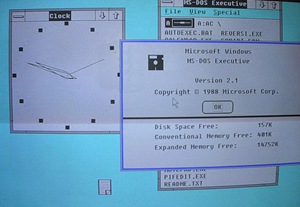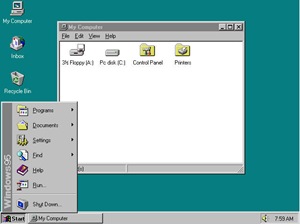Windows system requirements history
Comrades with CybernetNews were not too lazy and conducted a study of the chronology of the system requirements of the "beloved" Windows OS. Let us think about the scale of the development of technology that has occurred over the years.
Windows 1.0
Windows 1.0 was released on November 20, 1985.
- CGA / Hercules / EGA video adapter (or compatible)
- MS-DOS 2.0
- 256 KB Ram
- 2 drives or hard disk

Windows 2.10
Windows 2.1 officially released on May 27, 1988.
Interesting fact: Version 2.10 was released specifically to support the new Intel 286 processor.
- MS-DOS version 3.0 or higher
- 512 K RAM
- One drive and one hard drive
- Graphics adapter
- Microsoft mouse - optional
')
Windows 3.1x
Several versions of Windows 3.1 are released between 1992 and 1994.
An interesting fact: the main difference between this OS version was that the system installer refused to work on DOS systems other than MS-DOS.
- MS-DOS 3.1 or higher
- Intel 80286 processor (or higher)
- 1 MB of memory or higher (640K main and 256K extended)
- 6.5 MB of disk space (9 MB recommended)

Windows 95
Windows 95 released on August 24, 1995.
Interesting fact: the main improvement was the new graphical interface. In fact, the general format and structure of this GUI is still used in Windows.
- Intel 80386 DX CPU
- 4 MB RAM
- 50 MB on hard disk
Windows 98
Windows 98 released June 25, 1998
An interesting fact: Windows 98 was the first OS using WDM technology (Windows Driver Model).
- 486DX-2/66 MHz processor or higher (Pentium recommended)
- 16 MB RAM (24MB recommended)
- At least 500 MB of disk space
- Monitor with VGA resolution or higher
- CD-ROM or DVD-Rom drive
- Microsoft Mouse or other pointing device
Windows 2000
 Windows 2000 was released on February 17, 2000. 3 different versions of the system were released with different system requirements for each.
Windows 2000 was released on February 17, 2000. 3 different versions of the system were released with different system requirements for each.
Interesting fact: Microsoft advertised Windows 2000 as a “standard of reliability”. This system introduced new features such as Windows Desktop Update, Internet Explorer 5, and Outlook Express. There have also been significant improvements in Windows Explorer.
Windows 2000 Professional
- Pentium-compatible processor with a frequency of 133 MHz or higher
- 32 MB RAM (64 MB recommended)
- 700 MB hard drive (2 GB recommended)
Windows 2000 Server / Advanced Server
- 133 MHz CPU
- 256 MB RAM minimum
- 2 GB on a hard disk
Windows me
Windows Me released on September 24, 2000
Interesting fact: Windows Me was relevant for just over a year, after which Windows XP was replaced.
- Pentium processor with a frequency of 150 MHz
- 32 MB RAM
- 320 MB hard disk space
Note: This was the latest version of Windows with a real-mode MS-DOS subsystem, even though access to it was closed.

Windows xp
Windows XP was released on October 25, 2001.
Below are the minimum requirements for XP Home and Professional.
- 233 MHz processor
- 64 MB RAM
- 1.5 GB of free disk space
- SVGA video adapter and monitor
- CD-ROM or DVD drive
Windows vista
Windows Vista is introduced to the public on January 30, 2007.
An interesting fact: one of the main aspects for which this OS is criticized is its system requirements.
Vista Premium Ready
- 1.0 GHz processor
- 1 GB RAM
- 128 MB of video memory
- 40 GB hard drive
- 15 GB of free disk space
Indeed, the progress of the system requirements, which has occurred in all this time, is striking. Only the size of the RAM increased from 256 KB to 1 GB! One question remains open - what are the system requirements for the next Windows-based OS?
PS From myself I will add 2 links on which you can also find a lot of interesting things about the history of Windows:
Wikipedia article on Windows
History of Windows on MS
Windows 1.0
Windows 1.0 was released on November 20, 1985.
- CGA / Hercules / EGA video adapter (or compatible)
- MS-DOS 2.0
- 256 KB Ram
- 2 drives or hard disk

Windows 2.10
Windows 2.1 officially released on May 27, 1988.
Interesting fact: Version 2.10 was released specifically to support the new Intel 286 processor.
- MS-DOS version 3.0 or higher
- 512 K RAM
- One drive and one hard drive
- Graphics adapter
- Microsoft mouse - optional
')
Windows 3.1x
Several versions of Windows 3.1 are released between 1992 and 1994.
An interesting fact: the main difference between this OS version was that the system installer refused to work on DOS systems other than MS-DOS.
- MS-DOS 3.1 or higher
- Intel 80286 processor (or higher)
- 1 MB of memory or higher (640K main and 256K extended)
- 6.5 MB of disk space (9 MB recommended)

Windows 95
Windows 95 released on August 24, 1995.
Interesting fact: the main improvement was the new graphical interface. In fact, the general format and structure of this GUI is still used in Windows.
- Intel 80386 DX CPU
- 4 MB RAM
- 50 MB on hard disk
Windows 98
Windows 98 released June 25, 1998
An interesting fact: Windows 98 was the first OS using WDM technology (Windows Driver Model).
- 486DX-2/66 MHz processor or higher (Pentium recommended)
- 16 MB RAM (24MB recommended)
- At least 500 MB of disk space
- Monitor with VGA resolution or higher
- CD-ROM or DVD-Rom drive
- Microsoft Mouse or other pointing device
Windows 2000
 Windows 2000 was released on February 17, 2000. 3 different versions of the system were released with different system requirements for each.
Windows 2000 was released on February 17, 2000. 3 different versions of the system were released with different system requirements for each.Interesting fact: Microsoft advertised Windows 2000 as a “standard of reliability”. This system introduced new features such as Windows Desktop Update, Internet Explorer 5, and Outlook Express. There have also been significant improvements in Windows Explorer.
Windows 2000 Professional
- Pentium-compatible processor with a frequency of 133 MHz or higher
- 32 MB RAM (64 MB recommended)
- 700 MB hard drive (2 GB recommended)
Windows 2000 Server / Advanced Server
- 133 MHz CPU
- 256 MB RAM minimum
- 2 GB on a hard disk
Windows me
Windows Me released on September 24, 2000
Interesting fact: Windows Me was relevant for just over a year, after which Windows XP was replaced.
- Pentium processor with a frequency of 150 MHz
- 32 MB RAM
- 320 MB hard disk space
Note: This was the latest version of Windows with a real-mode MS-DOS subsystem, even though access to it was closed.

Windows xp
Windows XP was released on October 25, 2001.
Below are the minimum requirements for XP Home and Professional.
- 233 MHz processor
- 64 MB RAM
- 1.5 GB of free disk space
- SVGA video adapter and monitor
- CD-ROM or DVD drive
Windows vista
Windows Vista is introduced to the public on January 30, 2007.
An interesting fact: one of the main aspects for which this OS is criticized is its system requirements.
Vista Premium Ready
- 1.0 GHz processor
- 1 GB RAM
- 128 MB of video memory
- 40 GB hard drive
- 15 GB of free disk space
Indeed, the progress of the system requirements, which has occurred in all this time, is striking. Only the size of the RAM increased from 256 KB to 1 GB! One question remains open - what are the system requirements for the next Windows-based OS?
PS From myself I will add 2 links on which you can also find a lot of interesting things about the history of Windows:
Wikipedia article on Windows
History of Windows on MS
Source: https://habr.com/ru/post/31521/
All Articles